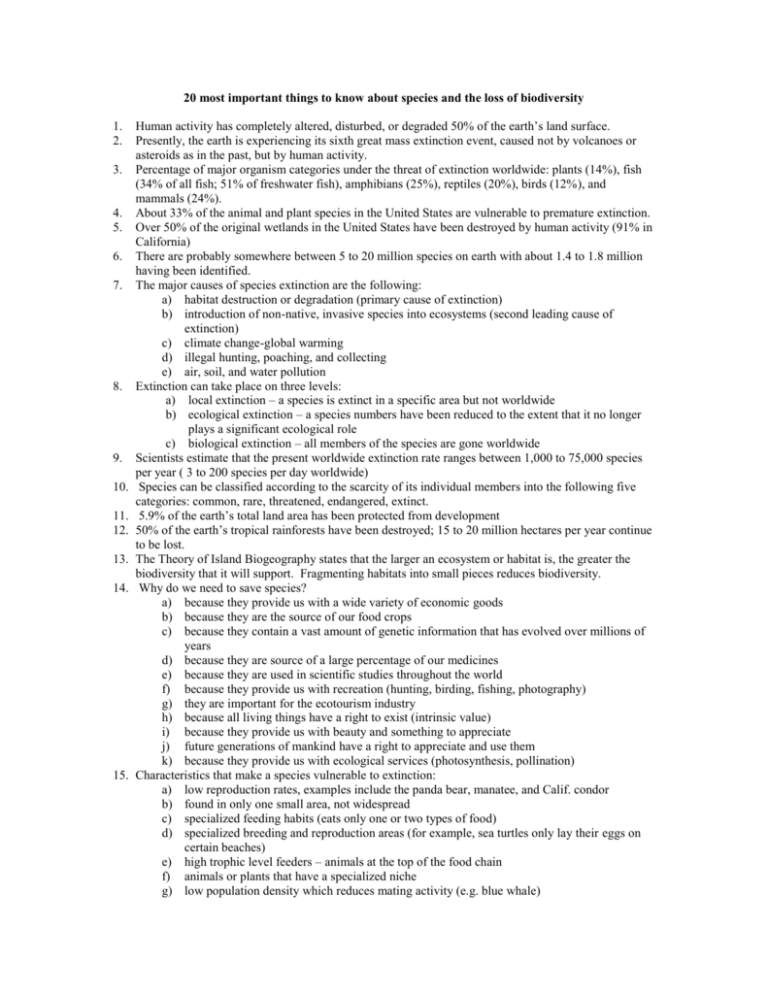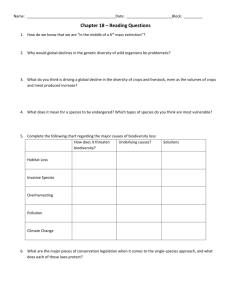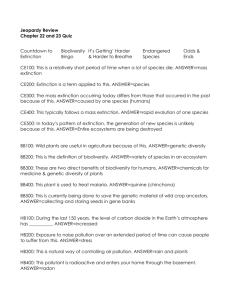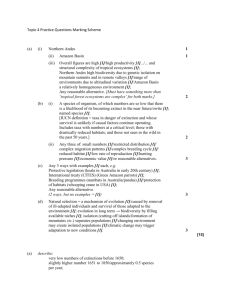20 most important things to know about species and
advertisement

20 most important things to know about species and the loss of biodiversity 1. 2. 3. 4. 5. 6. 7. 8. 9. 10. 11. 12. 13. 14. 15. Human activity has completely altered, disturbed, or degraded 50% of the earth’s land surface. Presently, the earth is experiencing its sixth great mass extinction event, caused not by volcanoes or asteroids as in the past, but by human activity. Percentage of major organism categories under the threat of extinction worldwide: plants (14%), fish (34% of all fish; 51% of freshwater fish), amphibians (25%), reptiles (20%), birds (12%), and mammals (24%). About 33% of the animal and plant species in the United States are vulnerable to premature extinction. Over 50% of the original wetlands in the United States have been destroyed by human activity (91% in California) There are probably somewhere between 5 to 20 million species on earth with about 1.4 to 1.8 million having been identified. The major causes of species extinction are the following: a) habitat destruction or degradation (primary cause of extinction) b) introduction of non-native, invasive species into ecosystems (second leading cause of extinction) c) climate change-global warming d) illegal hunting, poaching, and collecting e) air, soil, and water pollution Extinction can take place on three levels: a) local extinction – a species is extinct in a specific area but not worldwide b) ecological extinction – a species numbers have been reduced to the extent that it no longer plays a significant ecological role c) biological extinction – all members of the species are gone worldwide Scientists estimate that the present worldwide extinction rate ranges between 1,000 to 75,000 species per year ( 3 to 200 species per day worldwide) Species can be classified according to the scarcity of its individual members into the following five categories: common, rare, threatened, endangered, extinct. 5.9% of the earth’s total land area has been protected from development 50% of the earth’s tropical rainforests have been destroyed; 15 to 20 million hectares per year continue to be lost. The Theory of Island Biogeography states that the larger an ecosystem or habitat is, the greater the biodiversity that it will support. Fragmenting habitats into small pieces reduces biodiversity. Why do we need to save species? a) because they provide us with a wide variety of economic goods b) because they are the source of our food crops c) because they contain a vast amount of genetic information that has evolved over millions of years d) because they are source of a large percentage of our medicines e) because they are used in scientific studies throughout the world f) because they provide us with recreation (hunting, birding, fishing, photography) g) they are important for the ecotourism industry h) because all living things have a right to exist (intrinsic value) i) because they provide us with beauty and something to appreciate j) future generations of mankind have a right to appreciate and use them k) because they provide us with ecological services (photosynthesis, pollination) Characteristics that make a species vulnerable to extinction: a) low reproduction rates, examples include the panda bear, manatee, and Calif. condor b) found in only one small area, not widespread c) specialized feeding habits (eats only one or two types of food) d) specialized breeding and reproduction areas (for example, sea turtles only lay their eggs on certain beaches) e) high trophic level feeders – animals at the top of the food chain f) animals or plants that have a specialized niche g) low population density which reduces mating activity (e.g. blue whale) 16. 17. 18. 19. 20. h) species that interfere with human activity (e.g. wolves) i) large size which can make a species a more visible target or more commercially valuable. What can be done to save species? a) save habitat by establishing or enlarging parks, wildlife preserves, and wilderness areas b) regulate privately owned land c) pass laws to protect species d) reduce human population growth and consumption e) restore damaged habitats and reforest damaged forest areas f) establish captive breeding programs and seed banks g) educate the public on how to care for and protect the environment h) reduce and control pollution i) reduce the effects of global warming and ozone depletion j) prevent the establishment of non-native, invasive species into ecosystems What are important pieces of legislation that help to protect species? a) Endangered Species Act (1973) – protects species in danger of becoming extinct b) C.I.T.E.S. Treaty (1975) International treaty that protects species throughout the world c) Lacey Act (1900) – prohibits transporting wild animals across state boundaries d) Wilderness Act (1964) – preserves wilderness habitats permanently The three most biologically productive and species rich areas on earth are the tropical rainforests, wetlands, and coral reefs. It is estimated that at least 40% of all species are found within the tropical rain forests. It is important that private land owners work with conservationists to save species and habitat because over 55% of the land in the U.S. is privately owned. Assignment for APES 10/22/15 NOTE: Work in groups of 4. Spread out the work and share what you find with each other. Due on day of test! (Wednesday). Ginny will do presentation on Monday. I will wrap up on Monday. Below are some notable endangered species. Research HIPPCO charactericstics that affects each of the following and provide solutions or acts that are in place to try to mitigate the problem. (Doesn’t have to be extensive. Just get the general idea for each.) gray wolf whooping crane California Condor both Elephant species Cheetahs Indian/Sumatran Tiger Grizzly bear Atlantic Salmon Black Rhino Panda Bear Mountain Gorilla Desert Tortoise Florida Manatee Spotted Owl Florida Panther all Sea Turtles Blue Whale







